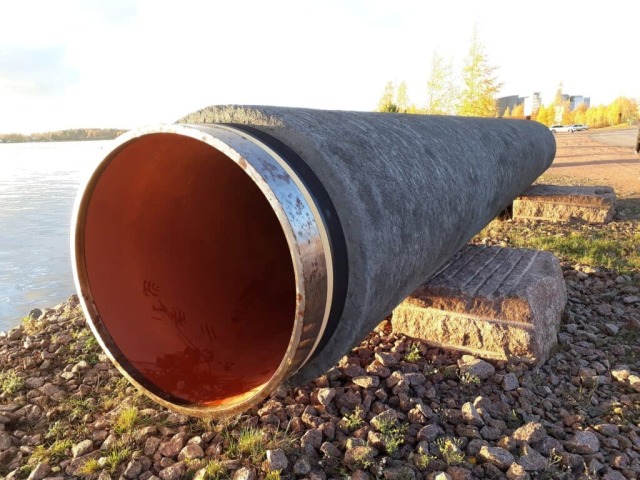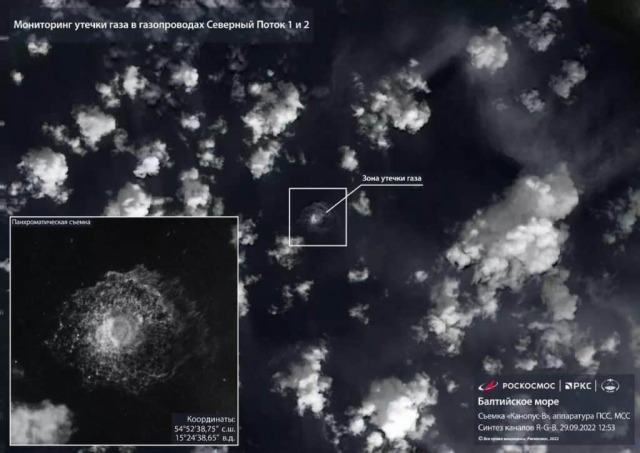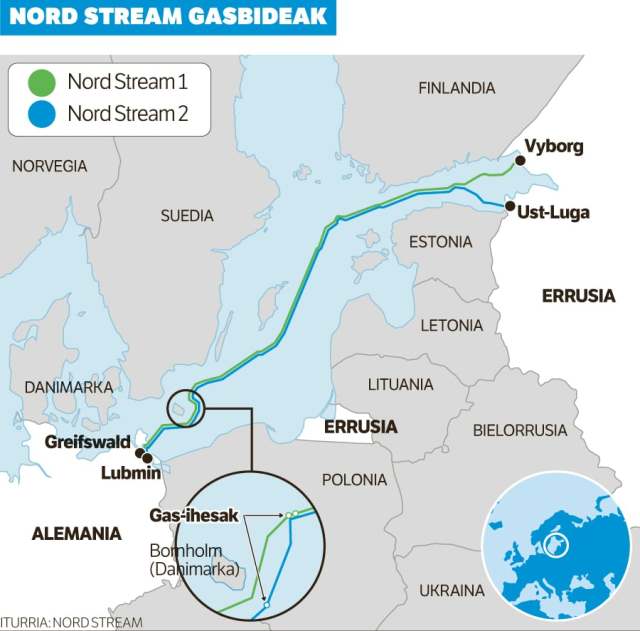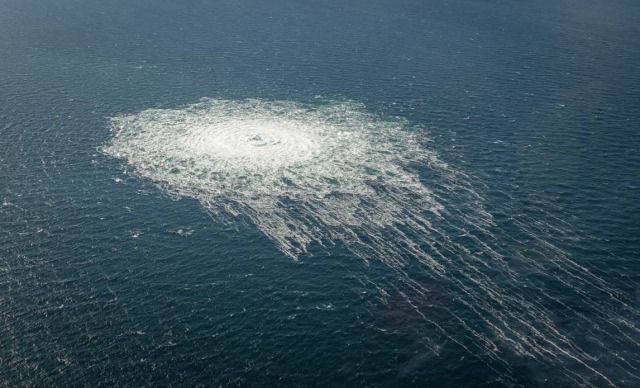At the end of September, for reasons not yet established, there were leaks on the Nord Stream gas pipelines. Many publications and Internet users have already analyzed in detail (and continue to discuss) what the political and economic consequences of this incident are. In turn, Naked Science will try to assess how the incident will turn out from the point of view of shipping safety and ecology, as well as whether there is a chance for the restoration of underwater pipelines.
What happened? During the day of September 26, several powerful underwater explosions occurred in the exclusive economic zone of Denmark northeast of Bornholm Island. They were registered by seismographs located in the area: the first, with a magnitude of 2.3 at 02:03 local time, the second — at 19:03 and a magnitude of 2.1. At the same time, the pressure drop in the gas pipelines was recorded by German receiving stations. During a visual inspection of the sea surface over the routes of the "Northern Streams", the aircraft of the Danish Armed Forces found gas outlets — colossal spots of boiling water.
At the time of the incident, the gas pipelines were not used due to the current geopolitical situation, but they contained gas under pressure. Both "Nord Streams" are pairs of "threads", each of which is made up of about a hundred thousand pipe segments with an internal diameter of about 1150 millimeters. From the outside they are covered with a concrete jacket, the thickness of the steel walls varies from three to four centimeters — the largest on the Russian side, the smallest on the German side, where the pressure is already falling. With an estimated operating pressure of up to 22 megapascals, the gas pipeline had to withstand the weight of the submerged ship. At the time of writing, damage to three "threads" has been confirmed, the fourth is still intact. Leaks occurred at depths not exceeding 100 meters.

A segment of the pipe from which the "Northern Streams" are made up at the exposition in Kotka, Finland. Each such section weighs about 24 tons. It took about one hundred thousand segments to build one "thread" with a length of more than 1200 kilometersImage source: Vuo, Wikimedia
What exactly happened to the "Northern Streams" has yet to be established during the investigation. Several interested parties, including Russia, promised to hold them at once. The main version is a diversion, and the only question is who carried it out. Nevertheless, an unforeseen release of huge volumes of gas (not only greenhouse, but also highly flammable) cannot be safe and pass without consequences for the environment, shipping and the gas pipeline itself.
Temporary Baltic Bermuda Triangle
Saturation of water with gas bubbles dramatically reduces its density and surface tension. Because of this, vessels caught in the zone of gas release to the sea surface risk losing buoyancy. To do this, it is necessary that the dimensions of this zone be comparable to the dimensions of the ship. In the case of leaks on the "Northern Streams", this is more than realistic — the smallest of the spots of bubbling methane bubbles in the Baltic Sea is about 200 meters in diameter. And the largest one is more than a kilometer across.
Methane, the main component of natural gas, is twice as light as air, but it does not rise up at lightning speed. This means that the formation of a torch is possible above the place of its exit to the surface of the water. This is the second reason why safety zones with a radius of five nautical miles have been declared around leaks. However, they do not affect shipping much. However, it is not at all clear for how long these waters will be closed, since gas can leave the pipeline for a long time — up to two weeks.

Satellite image of the leak site taken by the Canopus-V spacecraft on September 29Image source:
Roscosmos
The future of the gas pipeline
The most understandable problem of all is engineering. The probability of complete failure of gas pipelines is very high. The fact is that the anticorrosive coating protecting the pipes from the effects of seawater is applied only to their outer surface under the concrete jacket. From the inside, the sections of which the "Northern Streams" are made up are covered only with an antifriction compound. As soon as the pressure in the pipes drops below a certain value, water will begin to flow into them. And as soon as most of the gas comes out, it will replace it completely.
For some time, the antifriction coating will be able to protect the steel from corrosion, but if repairs are not carried out quickly, the gas pipeline is doomed. The trouble is that it is impossible to even assess the damage until the volume of leaks drops to very insignificant. Due to the risk of loss of buoyancy and possible fire, repair vessels cannot approach the accident site. In addition, the restoration of the gas pipeline may stall due to the political situation. As a result, even when the integrity of the pipes can be physically restored, it may turn out that the probability of corrosion is too high. Then the operation of the "Northern Streams" will simply be permanently banned for security reasons.
According to the most optimistic estimates, technically the gas pipelines can be back in operation by the end of 2023. But this is possible only if all the necessary measures can be implemented promptly. Otherwise, the fate of the "Northern Streams" is in great doubt.
Ecology
From the point of view of environmental impact, leaks from gas pipelines carry two threats at once. One is short—term, for marine flora and fauna, the second is delayed, associated with global warming.
Methane affects fish the most, for them it is toxic . At concentrations above a milligram per liter, fish "get drunk": within a few seconds, they first show excitement, then disorientation in space. If the exposure lasts more than 15 minutes, most species are doomed to die in a day or two. Fortunately, even at concentrations of about 0.02-0.05 milligrams per liter, methane becomes noticeable for fish. They usually try to avoid water with a high methane content, but a fast, powerful flow of bubbles during a leak from a gas pipeline can become a trap.
Once in the body of fish, methane damages their gills, chemoreceptors, skin and eyes. It also fills the swim bladder, which is why control over buoyancy is lost. Methane has similar effects on shellfish. Plankton is much more resistant: 2-5 milligrams of methane per liter of water are fatal for it.

Places of leaks from the Nord Stream — 1 and Nord Stream — 2 gas pipelines on the map of the Baltic SeaImage Source: Berria
In general, we can say that a leak from a gas pipeline is definitely not a life-giving gift for marine life, but it cannot be called an outstanding catastrophe either. A certain number of fish, shellfish and plankton will suffer, but there should be no long-term consequences for flora and fauna.
Global warming
The European community is seriously concerned about the impact of hundreds of thousands of tons of the contents of the "Northern Streams" that have entered the atmosphere on the climate. The fact is that methane is a much stronger greenhouse gas than the notorious carbon dioxide. Despite the fact that CH4 almost completely decays in the atmosphere in 10-12 years, its contribution to the greenhouse effect on the secular horizon is 21-40 times higher than that of CO2 (and 56-86 times higher on the 20-year horizon). This means that the indirect effects of the presence of additional methane in the atmosphere affect for a longer time than the gas itself is present in it.
Given the variation in estimates of the impact of methane on global warming, it is quite difficult to calculate the long-term effects of leaks on the "Northern Streams". In addition, the volumes of gas released into the atmosphere are not yet fully understood. The primary data, which will be precisely corrected later, are as follows: at the beginning of the leaks (when the pressure in the gas pipeline was maximum), about 500 tons of methane per hour came out of the gaps in the pipes. The volume of gas in the pipeline was 300 million cubic meters, but in fairness it should be said that the source did not specify whether this only concerns Nord Stream —2 or both gas pipelines.

The removal of permafrost is one of the processes by which metastable methane hydrates disintegrate and release this greenhouse gas into the atmosphereImage Source: George Kling, Oregon State University
Total methane emissions into the atmosphere will exceed 200 thousand tons. For comparison: in terms of the impact on the climate, this is equivalent to 20 years of driving 5.48 million average American cars. Or — almost a third of the annual emissions of the entire Danish economy. By the way, since the incident occurred in the exclusive economic zone of Denmark, this country has every chance to bear the environmental burden of greenhouse gas leaks.
How serious is this
On the one hand, the universal concern about global warming does not exist from scratch. The consequences of global climate change are difficult to predict and can be catastrophic. Although there will also be positive effects from this phenomenon [...] (and even observed throughout the XX century), an unambiguous answer to the question of whether they will outweigh the negative consequences or not has not yet been found. In this light, the extra two hundred kilotons of powerful greenhouse gas in the atmosphere are sad: this is 0.035% of global annual methane emissions in a matter of days. It seems quite a bit, but this is the result of a single event.
At the same time, it cannot be said that fluctuations in methane emissions are something unusual, and the phenomenon itself is extraordinary for the ocean. Deposits of methane clathrates (hydrates) — "combustible ice" - are stored on the seabed all over the world. These are compounds of water with methane that occur at low temperatures and high pressure. Sometimes, by coincidence, they disintegrate, and as a result, the gas enters the water. Similar processes are taking place in regions where permafrost is melting. In other words, methane enters the atmosphere through water constantly, but this source is not the largest. According to annual volumes, permafrost and all geological processes on the seabed emit no more methane into the atmosphere than termites around the world (about 9-12 megatons). And the main natural source of methane is wetlands and freshwater reservoirs (about 180 and 120 megatons per year, respectively).
In the dry balance
By all indications, leaks on the "Nord Streams" will go down in history, if not as the largest, then as one of the largest anthropogenic one-time emissions. At the same time, they will have the most negative effect on the fate of the gas pipelines themselves. The financial losses will also be impressive. But shipping was not affected too much by this incident. The environmental consequences will also almost certainly not be catastrophic.

